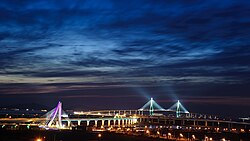This article needs additional citations for verification. (August 2012) |
Jung
중구 | |
|---|---|
| Korean transcription(s) | |
| • Hanja | 中區 |
| • Revised Romanization | Jung-gu |
| • McCune–Reischauer | Chung-gu |
 | |
 | |
| Country | South Korea |
| Region | Sudogwon |
| Provincial level | Incheon |
| Administrative divisions | 11 administrative dong |
| Area | |
• Total | 134.29 km2 (51.85 sq mi) |
| Population (2020) | |
• Total | 136,879 |
| • Density | 1,000/km2 (2,600/sq mi) |
| • Dialect | Seoul |
| Website | Jung District Office |
Jung District (Korean: 중구; RR: Jung-gu) is the historic central ward of the city of Incheon, South Korea, one of the eight wards into which Incheon is divided. Its name means "central" in Korean. It was founded in 1883 on the opening of the Jemulpo Port and contains several historical and cultural heritage monuments, such as Dap-dong Cathedral, Hongyemun Gate, The First Anglican Church, and Jayu Park, Korea's first modern park. Incheon Chinatown, the birthplace of jajangmyeon, is located in the district.
Incheon is the gateway to Seoul, the capital of South Korea. In modern times it became a trading port, eventually growing to become the second-largest port in South Korea. Incheon International Airport also locates in Jung District.
